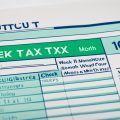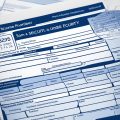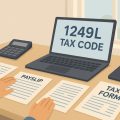A tax code plays a crucial role in determining how your earnings are taxed. If you’ve been assigned the D1 tax code, it means that all your income from this job will be taxed at the additional rate of Income Tax, which is 45%. Usually given to individuals with multiple jobs or pensions, the D1 tax code indicates that they have already utilized their personal allowances on their primary income. It’s vital to keep track of your tax codes to ensure accuracy and avoid overpaying or underpaying taxes.
Understanding the D1 tax code is essential to manage your finances effectively. This tax code signifies that all your income from your current employment or pension will be subject to the additional rate of 45% tax. The assignment of the D1 tax code is based on your individual circumstances and is applicable if your taxable income exceeds £125,140 per year. To ensure the accuracy of your tax code, you can easily check it online through your personal tax account or the HMRC app. For additional rate taxpayers, completing a self-assessment tax return may be necessary to calculate the accurate tax owed across all income sources.
In order to check and update your D1 tax code, access your personal tax account or HMRC app. These platforms provide easy access to information about your tax code for all your income sources, allowing you to review its accuracy. If you identify any changes in your circumstances that may affect your personal tax allowances and tax code, it’s important to inform HMRC and request an update. Ensuring the correctness of your D1 tax code is crucial to avoid any discrepancies in tax payments. You can also utilize a D1 tax code calculator to estimate your tax liability more accurately.
Under the D1 tax code, you do not have a tax-free personal allowance for income subject to this code. All income falling under the D1 tax code is taxed at the additional rate of 45%. Bear in mind that tax rates and bands may change annually, so staying updated with any updates from the government regarding additional rate tax is advisable. Additionally, a D1 tax code calculator can help you understand the exact amount of tax you’ll be required to pay under this code.
In conclusion, the D1 tax code is assigned to individuals with multiple jobs or pensions, signifying that their income from this particular source will be subject to the additional rate of Income Tax, which is 45%. Managing your tax codes accurately is essential to ensure proper tax payments. If you have any concerns or need to update your tax code, it’s recommended to contact HMRC. Familiarizing yourself with the D1 tax code and its implications will enable you to calculate your taxes correctly and fulfill your tax obligations in the UK.
Understanding the D1 Tax Code
The D1 tax code is an important aspect of the UK tax system that individuals must comprehend to accurately calculate their tax liabilities. This section will provide a comprehensive understanding of the D1 tax code and its implications on your income.
The D1 tax code signifies that all income from your current employment or pension is subject to the additional rate of 45% tax. This code is assigned by HMRC, the UK tax authority, based on your individual circumstances and income level. If your taxable income exceeds £125,140 annually, you will be assigned the D1 tax code.
It is crucial to check your tax code regularly to ensure its accuracy. You can do this conveniently by accessing your personal tax account or HMRC app online. Verifying your tax code online will provide you with up-to-date information on the tax you owe based on your specific circumstances.
If you are an additional rate taxpayer, you may need to complete a self-assessment tax return. This process allows you to calculate the tax owed from all your income sources accurately. By diligently monitoring your tax code and fulfilling your tax obligations, you can avoid potential penalties or incorrect tax payments.
How to Check Your D1 Tax Code?
Checking your D1 tax code is a simple process that can be done through various online platforms. Here’s how you can verify your tax code:
- Access your personal tax account or HMRC app.
- Login to your account using your unique credentials.
- Navigate to the section that displays your tax code information.
- Review the code to ensure it reflects your income and personal circumstances accurately.
If you spot any discrepancies or believe your tax code needs updating, it is crucial to contact HMRC immediately. Inform them of any changes in your circumstances that may affect your tax allowances or personal tax code. By keeping your tax code up to date, you can ensure that you are paying the correct amount of tax.
Understanding the D1 tax code is essential for navigating the UK tax system effectively. By familiarizing yourself with this code, regularly checking its accuracy, and taking appropriate action when necessary, you can confidently manage your tax obligations and avoid any undue financial burdens.
How to Check and Update Your D1 Tax Code?
If you have been assigned a D1 tax code, it is crucial to regularly check its accuracy to ensure that you are paying the correct amount of taxes. The easiest way to check your tax code is by accessing your personal tax account or using the HMRC app. These platforms provide a convenient and user-friendly interface where you can review your tax code information for all your income sources.
Once you have accessed your tax account or app, navigate to the section that displays your tax code. Here, you will find the details of your D1 tax code and any other relevant information about your tax allowances and deductions.
If you suspect that your D1 tax code needs to be updated due to changes in your circumstances—which may include changes in employment or pensions—you should contact HMRC. By informing them of any changes, they can update your tax code accordingly to ensure that you are not overpaying or underpaying taxes.
It is important to remember that your D1 tax code affects the amount of tax you will pay on all your income from the specific job or pension associated with this code. If your code is incorrect, it could result in significant discrepancies in your tax payments.
Additionally, you can use a D1 tax code calculator to estimate your tax liability accurately. These calculators take into account the tax rates and allowances associated with the D1 tax code to provide you with an estimate of the amount you owe. This can be especially useful if you have multiple sources of income or complex tax situations.
By regularly checking and updating your D1 tax code, you can ensure that your tax payments align with your circumstances and avoid any unnecessary financial complications.

| Steps to Check and Update Your D1 Tax Code: |
|---|
| 1. Access your personal tax account or HMRC app. |
| 2. Navigate to the section that displays your tax code. |
| 3. Review the details of your D1 tax code and any accompanying information. |
| 4. Contact HMRC if your tax code needs to be updated due to changes in your circumstances. |
| 5. Utilize a D1 tax code calculator to estimate your tax liability accurately. |
The D1 Tax Code and Personal Allowance
Under the D1 tax code, your income is not eligible for a tax-free personal allowance. Instead, all your income subject to this code will be taxed at the additional rate of 45%. It’s important to note that tax rates and bands can change each tax year, so staying informed about any updates regarding additional rate tax from the government is crucial.
To gain a better understanding of the amount of tax you’ll be required to pay under the D1 tax code, you can utilize a D1 tax code calculator. This tool will help you estimate your tax liability accurately, ensuring you can plan your finances accordingly. By inputting your income information and other relevant details, the calculator will provide you with an estimate of the tax due.
Example
| Income Source | Income Amount |
|---|---|
| Primary Job | £40,000 |
| Secondary Job | £20,000 |
| Pension | £15,000 |
In this example, if all three income sources are subject to the D1 tax code, the total taxable income would be £75,000 (£40,000 + £20,000 + £15,000). As the D1 tax code indicates that no tax-free personal allowance applies, the entire £75,000 would be taxed at the additional rate of 45%. Based on this, using a D1 tax code calculator will help determine that the tax owed would be £33,750 (£75,000 x 0.45).
Calculating your taxes accurately is essential to avoid any underpayment or overpayment of taxes. By understanding the implications of the D1 tax code and utilizing the available tools, you can stay on top of your tax obligations and ensure compliance with HMRC regulations.

Conclusion
Understanding the D1 tax code is crucial for individuals in the UK who have multiple jobs or pensions. This code signifies that their income from this particular source will be subject to the additional rate of Income Tax, which is 45%. To ensure accurate tax payments, it is important to keep track of your tax codes and verify their accuracy regularly.
If you have concerns or need to update your tax code, it is recommended to contact HMRC. They can assist you in making any necessary changes based on your individual circumstances. By staying informed and understanding the implications of the D1 tax code, you can calculate your taxes correctly and fulfill your tax obligations in the UK.
Remember, taxes play a vital role in supporting public services and infrastructure in the UK. By properly managing your tax codes and payments, you contribute to the functioning of the country’s economy. Be proactive in reviewing your tax information and consult HMRC whenever you have questions or require assistance related to your D1 tax code.




















No Comments
Leave a comment Cancel